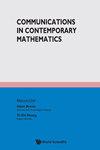The Kauffman bracket skein module of the lens spaces via unoriented braids
IF 1.2
2区 数学
Q1 MATHEMATICS
引用次数: 2
Abstract
. In this paper we develop a braid theoretic approach for computing the Kauffman bracket skein module of the lens spaces L ( p,q ), KBSM( L ( p,q )), for q 6 = 0. For doing this, we introduce a new concept, that of an unoriented braid . Unoriented braids are obtained from standard braids by ignoring the natural top-to-bottom orientation of the strands. We first define the generalized Temperley-Lieb algebra of type B , TL 1 ,n , which is related to the knot theory of the solid torus ST, and we obtain the universal Kauffman bracket type invariant, V , for knots and links in ST, via a unique Markov trace constructed on TL 1 ,n . The universal invariant V is equivalent to the KBSM(ST). For passing now to the KBSM( L ( p, q )), we impose on V relations coming from the band moves (or slide moves), that is, moves that reflect isotopy in L ( p, q ) but not in ST, and which reflect the surgery description of L ( p, q ), obtaining thus, an infinite system of equations. By construction, solving this infinite system of equations is equivalent to computing KBSM( L ( p,q )). We first present the solution for the case q = 1, which corresponds to obtaining a new basis, B p , for KBSM( L ( p, 1)) with ( ⌊ p/ 2 ⌋ +1) elements. We note that the basis B p is different from the one obtained by Hoste & Przytycki. For dealing with the complexity of the infinite system for the case q > 1, we first show how the new basis B p of KBSM( L ( p, 1)) can be obtained using a diagrammatic approach based on unoriented braids, and we finally extend our result to the case q > 1. The advantage of the braid theoretic approach that we propose for computing skein modules of c.c.o. 3-manifolds, is that the use of braids provides more control on the isotopies of knots and links in the manifolds, and much of the diagrammatic complexity is absorbed into the proofs of the algebraic statements.考夫曼支架通过无方向编织将透镜空间绞接模块
. 本文提出了一种计算透镜空间L (p,q), KBSM(L (p,q)),当q 6 = 0时的Kauffman支架束模的编织理论方法。为了做到这一点,我们引入了一个新的概念,即无定向编织。无定向编发是从标准编发中获得的,忽略了发丝从上到下的自然方向。我们首先定义了与固体环面ST的结理论相关的B, TL 1,n型广义Temperley-Lieb代数,并通过构造在TL 1,n上的唯一马尔可夫迹,得到了ST中结和连杆的普遍Kauffman支架型不变量V。普遍不变量V等价于KBSM(ST)。现在转到KBSM(L (p, q)),我们施加来自带移动(或滑动移动)的V关系,即反映L (p, q)而不是ST中的同位素的移动,并且反映L (p, q)的手术描述,从而获得无限方程组。通过构造,求解这个无穷方程组等价于计算KBSM(L (p,q))。我们首先给出了q = 1情况下的解,对应于得到了一个新的基,即具有(⌊p/ 2⌋+1)元素的KBSM(L (p, 1))的B p。我们注意到基B p与Hoste & Przytycki得到的基B p不同。为了处理qb>情况下无限系统的复杂性,我们首先给出了如何利用基于无向编织的图解方法获得KBSM(L (p, 1))的新基bp,并将结果推广到qb>情况。我们提出的用于计算c.c.o 3流形串模的编织理论方法的优点是,使用编织提供了对流形中结和链的同位素的更多控制,并且许多图解复杂性被吸收到代数陈述的证明中。
本文章由计算机程序翻译,如有差异,请以英文原文为准。
求助全文
约1分钟内获得全文
求助全文
来源期刊
CiteScore
2.90
自引率
6.20%
发文量
78
审稿时长
>12 weeks
期刊介绍:
With traditional boundaries between various specialized fields of mathematics becoming less and less visible, Communications in Contemporary Mathematics (CCM) presents the forefront of research in the fields of: Algebra, Analysis, Applied Mathematics, Dynamical Systems, Geometry, Mathematical Physics, Number Theory, Partial Differential Equations and Topology, among others. It provides a forum to stimulate interactions between different areas. Both original research papers and expository articles will be published.

 求助内容:
求助内容: 应助结果提醒方式:
应助结果提醒方式:


